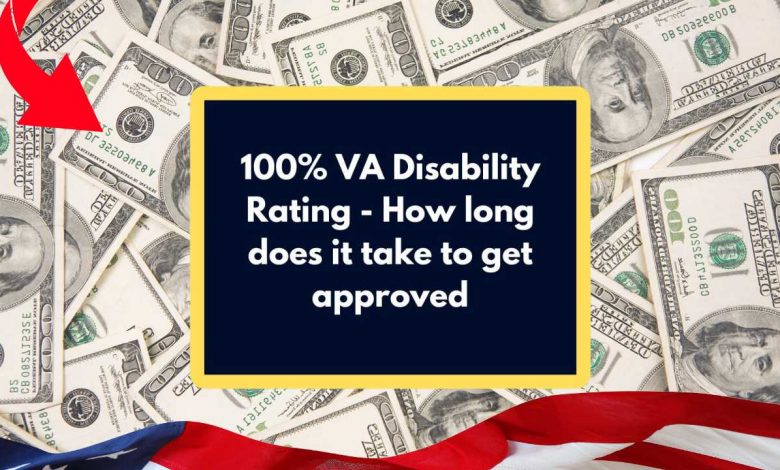100% VA Disability Rating – How long does it take to get approved & What is the Wait time?

When veterans apply for a 100% VA disability rating, they are seeking monthly disability benefits from the Department of Veterans Affairs. These benefits are available to those with service-related disabilities, which can be internal, psychological, or physical conditions that have a major influence on their life and are directly related to military service.
Once veterans apply and are rated by the VA, their disability rating determines their monthly benefit payments. The ratings range from 0% to 100%, with a higher grade leading to larger benefit payments. Even a slight improvement in the rating can make a significant impact on what veterans can afford.
The VA form to apply for a rating can be submitted through the official portal, contacting a local office, or sending an application in person. After the claim is submitted, veterans may need to complete additional steps to receive their payments.
Understanding the approval process for a 100% disability claim and knowing the wait time is crucial. This article provides an overview of the approval process, so veterans can get an idea of how long it might take for the VA to approve their claim and when they can expect their benefits.
100% VA Disability Rating
The VA disability rating can go down or up depending on various factors. If the department finds that your condition has enhanced, they may decide to lower your rating. To avoid this, it’s crucial to follow your treatment procedure, take all recommended medications, and visit your doctor regularly for routine check-ups. By continuing your therapy and visits, the VA will know you still need disability benefits. However, if you stop these visits, they may assume you no longer need the support.
If your illness, like Parkinson’s disease or cancer, worsens over time, you can request a revaluation or appeal to have your rating raised. As your symptoms get worse, you might see an increase in your disability rating, which can lead to numerous additional benefits. But remember, conditions that worsen with time can influence how much support you are eligible for. So, staying consistent with treatment is key to maintaining or even improving your rating.
Overview of the VA Disability Process in 2025
Article on 100% VA disability approval timeline.
Department: US Department of Veterans Affairs (USDA).
Country: United States of America (USA).
Year of information: 2025, for reference purposes.
Beneficiaries: Veterans with service-related or disabling conditions.
Category: Finance, related to disability claims and compensation.
Official Website: va.gov for further detailed information.
Eligibility for 100 Percent VA Disability
To qualify for a 100 percent Veteran Disability Rating, a beneficiary must show that their service-related condition is totally disabling and prevents them from doing gainful work. This can be due to a single condition or a combination of service-related disabilities that obstruct their ability to carry out everyday work and affect their functioning capacity.
When the Veteran Affairs department evaluates your claim, they will review the credentials you submitted, including C&P exam results, medical reports, and other pertinent conclusions that support your claim.
The valuations focus on the seriousness of your symptoms, considering both the individual condition and the overall impact of service-related disabilities. This thorough process helps to calculate VA disability ratings and determine the appropriate level of benefits based on your situation.
Required Documents for VA Claim
When filing for a VA Disability benefit, make sure to provide the appropriate type of evidence that meets the requirements for a specific disability rating. There are three vital sorts of evidence needed:
- Lay evidence: Statements from individuals who know the beneficiary and their disability.
- Medical evidence: Includes medical records and succeeding treatment records.
- Expert opinion evidence: Suggestions from medical specialists, professional specialists, or other experts.
What Happens After VA Disability is Claimed?
Step 1: Claim Received
When you submit your disability claim, either online or mailed, the VA will notify you that they’ve received your application. If you’ve filed your claim online, you’ll get a notification soon after submission. For those who mail their application, the VA will send a letter confirming receipt within 7-14 days. This is an important first step to tracking your claim’s progress.
Step 2: Initial Review
After the VA has received your claim, a Veterans Service Representative will begin the initial review. During this phase, they may request additional supporting documentation to move forward with the claim. Only once the VA has everything they need, they’ll proceed to step 3. Stay attentive for any letters or notifications that might ask for extra documents to avoid delays in processing.
Step 3: Evidence Collection
In Step 3: Evidence Collection, the VA may take different actions to move forward with your claim. They might ask for proof from medical professionals, the government, or other parties. You may also need to schedule an appointment for a Compensation and Pension exam. Additionally, a Ratings Veteran Service Representative might reach out to discuss your claim further.
Step 4: Review the Evidence
After collecting all necessary evidence, Step 4: Review the Evidence begins. The VA will carefully examine the evidence in your claim file to ensure everything is in order. If additional information is needed during the evaluation, your claim could be sent back for further review, possibly more than once, until all aspects are fully evaluated.
Step 5: Preparation for Conclusion
Once your VA disability claim file is with the RVSR, they will begin the process of reviewing your application and all the supporting documents you’ve submitted. This is a crucial step, as the RVSR will then start preparing the required paperwork. They will use this to explain their decision clearly and accurately, ensuring all aspects of your claim are addressed.
Step 6: Awaiting Approval of the Decision
After the RVSR has provided their recommendations, a final decision regarding your claim will be made after further review. This includes a detailed examination of the recommendations to determine if the claim should be approved and the award decision granted. It’s during this stage that the final steps towards your claim approval unfold.
Step 7: Getting Ready for the Notification
Once your claim decision is made, a Senior Veterans Service Representative will examine the submitted paperwork to ensure everything is accurate. If necessary, they will approve the release of your award letter and money. After this, you will receive the decision on your VA disability ratings by mail.
Step 8: Claim Finalized
The last stage of your claim process involves the VA sending your disability claim decision packet. This packet contains the final decision, signaling that your claim is now officially concluded. After receiving the packet, your claim process is complete.
How Can You Check VA Disability Claim Status?
After submitting your VA claim, it may take some time for the VA authority to make a final decision. However, there are several ways you can check the status and view updates. You can easily track the progress of your claim using the following methods:
- Call Veteran Affairs at 800-827-1000
- Log in to the VA appeals tracker
- Visit your local VA regional office
- File at va.gov, the official portal of the Department of VA
Understanding the Appeals Process
If you disagree with the disability rating given by the VA, you have the right to appeal. The appeals process allows veterans to request a review of their case, where they can submit new evidence or argue that the initial decision was incorrect.
The VA provides several avenues for appeals, including filing a Notice of Disagreement (NOD) and requesting a review or hearing. It’s essential to be aware of deadlines and follow the instructions closely to ensure the appeal is processed correctly.
Retroactive Payments and Backdating Claims
In some cases, veterans may be entitled to retroactive payments if the VA backdates the effective date of their disability rating. This typically happens when the VA determines that the disability existed before the claim was filed.
Veterans can receive compensation for the period between when they first became eligible for benefits and when their claim was formally approved. If you believe you are entitled to retroactive payments, it’s worth discussing with a VA representative or seeking assistance to ensure you receive all the compensation you are due.
The Role of Mental Health in VA Disability Ratings
Mental health conditions, including PTSD, depression, and anxiety, are often a significant part of veterans’ disability claims. The VA evaluates these conditions based on their impact on daily functioning and ability to work. If a mental health condition worsens, veterans can request a re-evaluation of their rating.
It’s crucial to document mental health symptoms and seek professional help regularly, as the VA gives considerable weight to consistent treatment and records when determining ratings for mental health disorders.
Stay Proactive and Communicate with the VA
Throughout the process of applying for or appealing a disability rating, communication is key. Veterans should ensure they provide all requested documents on time and keep track of any updates or requests from the VA.
Delays can occur if the VA doesn’t have all the necessary information, so it’s essential to stay proactive in monitoring your claim’s progress. Use available tools like the VA appeals tracker, or contact your local office to ensure everything is on track.
Frequently Asked Question
What is the typical wait time for a 100% VA disability rating approval?
The average wait time for a 100% VA disability rating approval can vary depending on the complexity of your case and the backlog at the VA. Typically, it takes between 90 to 120 days, but it can sometimes extend to 6 months or more.
Can I expedite my VA disability claim?
Yes, certain circumstances, such as financial hardship, terminal illness, or being a former prisoner of war, may qualify you for expedited processing. You’ll need to notify the VA and provide documentation to support your request.
What factors can delay the VA disability claim process?
Delays can occur due to incomplete documentation, scheduling conflicts for Compensation and Pension (C&P) exams, or if the VA requires additional evidence to evaluate your claim. Proactively providing all necessary information can help minimize delays.
How does the VA determine a 100% disability rating?
The VA assigns a 100% disability rating when they determine that your service-connected condition(s) render you unable to engage in substantially gainful employment. This may involve a single disabling condition or a combination of conditions that meet this criterion.
What is the Compensation and Pension (C&P) exam, and is it mandatory?
The C&P exam is a medical evaluation performed by a VA healthcare provider to assess the severity of your condition. It is a crucial part of the claims process and is mandatory for most disability claims unless sufficient medical evidence is already provided.
Can my 100% disability rating be reduced over time?
Yes, the VA can lower your rating if they determine that your condition has improved. Regular treatment and documentation of your condition are critical to maintaining your rating. Certain ratings, however, may be protected based on duration or age.
Are mental health conditions eligible for a 100% VA disability rating?
Yes, mental health conditions like PTSD, depression, or anxiety can qualify for a 100% disability rating if they severely impact your ability to function in daily life and prevent gainful employment. Documentation and consistent treatment are key.
What documents should I submit with my VA disability claim?
Submit lay evidence (statements from individuals who know you), medical records, expert opinions, and any other documentation that supports your claim. Thoroughly documenting your condition can help speed up the evaluation process.
Can I appeal a VA disability decision if I disagree with the rating?
Yes, veterans have the right to appeal if they disagree with their rating. The appeals process includes submitting a Notice of Disagreement (NOD), requesting a higher-level review, or opting for a hearing with a Veterans Law Judge.
How can I track the status of my VA disability claim?
You can track your claim status online via the VA’s official portal (va.gov), by calling 800-827-1000, or by visiting your local VA regional office. Keeping track of updates ensures you respond promptly to any VA requests.
Conclusion
In conclusion, navigating the VA disability claims process can be complex and time-consuming, especially when seeking a 100% disability rating. Understanding each step of the process—from submitting your claim to tracking its status and knowing your rights to appeal—is essential for maximizing your benefits.
By staying proactive, maintaining clear communication with the VA, and consistently documenting your condition, you can improve your chances of a successful outcome. While the wait times can vary, patience and persistence are key in securing the compensation you deserve for your service-connected disabilities. For further support, don’t hesitate to consult VA resources or seek guidance from a trusted representative.



